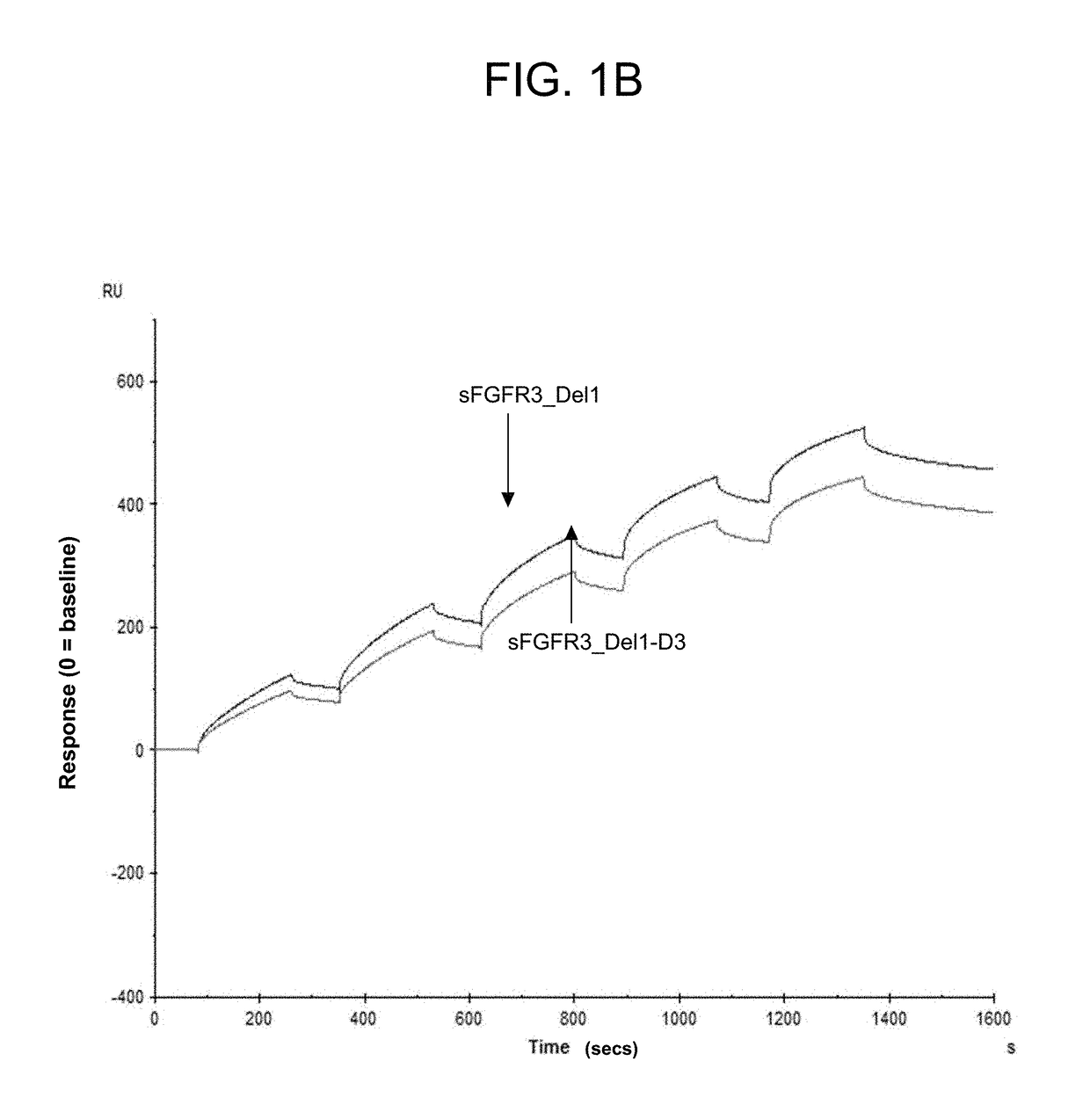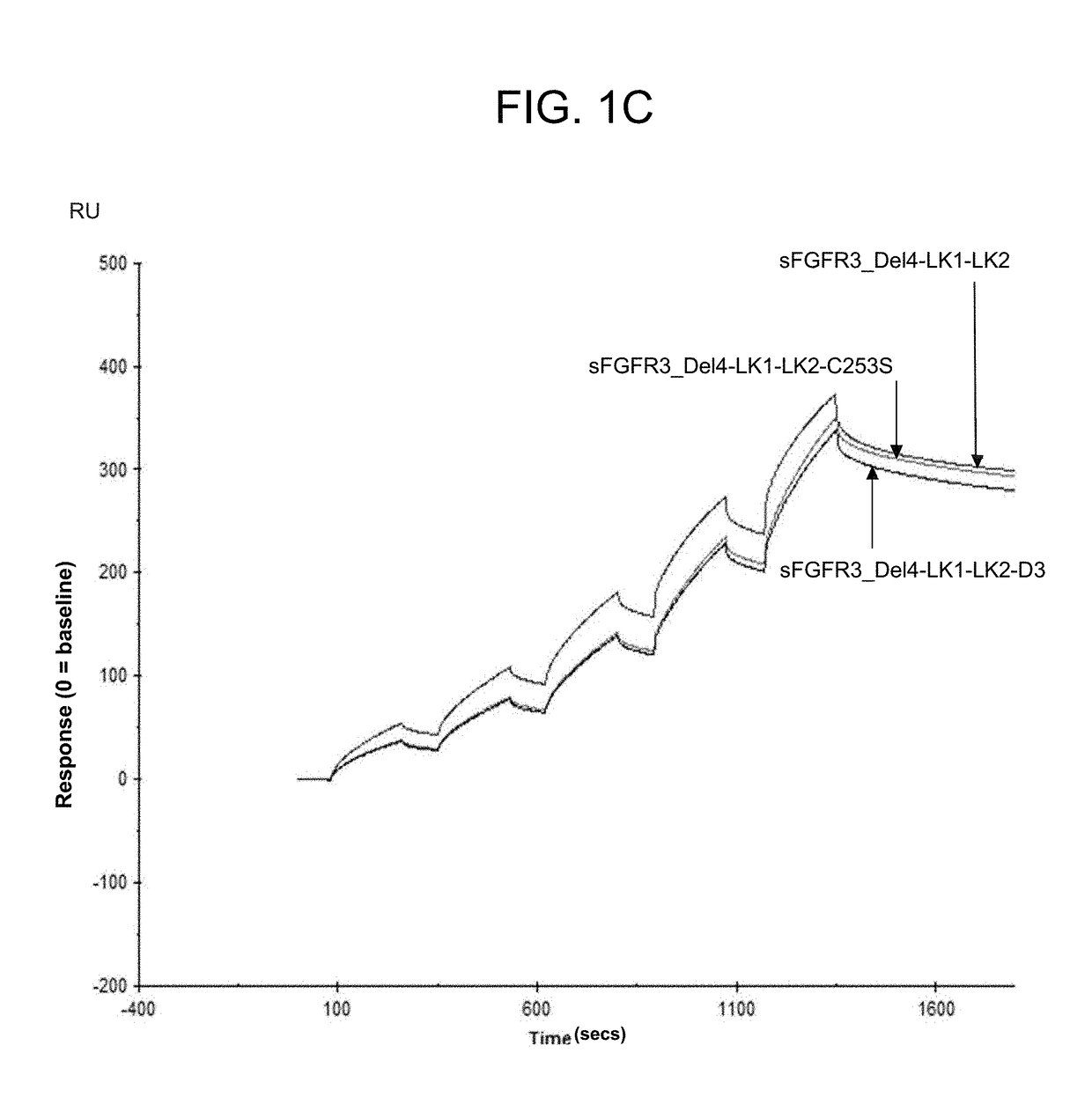Soluble fibroblast growth factor receptor 3 (sfgfr3) polypeptides and uses thereof
a technology of soluble fibroblast growth factor, which is applied in the direction of peptides/protein ingredients, drug compositions, peptides, etc., can solve the problems of impairing endochondral bone growth, and achieve the improvement of abdominal breathing, improving patient locomotion, and increasing survival of patients
- Summary
- Abstract
- Description
- Claims
- Application Information
AI Technical Summary
Benefits of technology
Problems solved by technology
Method used
Image
Examples
example 1
n of sFGFR3 Polypeptides
[0131]sFGFR3_Del4-C253S (SEQ ID NO: 2) and sFGFR3_Del4-D3 (SEQ ID NO: 33) were produced by transient transfection in three different suspension cell types: HEK 293 freestyle, CHO-S freestyle cells and Expi CHO-S cells. For production in HEK 293 freestyle and CHO-S freestyle cells, transfection was performed using polyethylenimine (PEIpro®—Polyplus-transfection), according to the manufacturer's directions. Proteins were harvested after three days. For sFGFR3 polypeptide production in Expi CHO-S cells, transfection was performed using Expifectamine as described by the manufacturer using the High Titer production protocol. A time course was performed and sFGFR3 polypeptides were optimally harvested after 12 days. Western blots were then performed using 50 ng of sFGFR3 polypeptide. Classical western blot protocols were used with B9 as a primary antibody (anti FGFR3, sc-13121, Santa Cruz) diluted 1:2000 in blocking buffer and anti-mouse IgG secondary antibody (Ant...
example 2
ion of sFGFR3 Polypeptides
[0132]sFGFR3_Del4-C253S and sFGFR3_Del4-D3 were each purified using a two-step purification process including ion exchange chromatography and size exclusion chromatography.
[0133]For ion exchange chromatography, 300 mL of culture supernatant was purified by cross flow filtration (ÄKTA™ flux, GE Healthcare) using 5 μm and 0.2 μm capsules (KGF-A0504 TT and KMP-HEC 9204 TT, GE Healthcare, respectively). The purified sample including sFGFR3_Del4-C253S or sFGFR3_Del4-D3 was then loaded on an equilibrated column at 20 mL / min, after adjusting the sample's conductivity to 14 mS / cm (ÄKTA™ pure 25 (GE Healthcare)). Columns used were HiPrep Q FF 26 / 10 (GE Healthcare) with a bed volume of 53 mL. The binding buffer was 1×PBS and the elution buffer was PBS 1×+1 M NaCl. The column was washed with four column volumes of 1×PBS. Elution of sFGFR3_Del4-C253S and sFGFR3_Del4-D3 was performed by two steps of 5% NaCl and 10% NaCl using four column volumes of each. Both 5% NaCl an...
example 4
tion Assays of sFGFR3 Polypeptides
[0135]Both ATDC5 and ATDC5 FGFR3G380R cell lines were seeded at a density of 25,000 cells / cm2 in NUNC™ MICROWELL™ 96-Well Optical-Bottom Plates with Polymer Base (ThermoFisher Scientific, Catalog No. 165305). After a 24 hour incubation period, cells were depleted for 48 hour in 0.5% BSA and then stimulated for 72 hour with sFGFR3_Del4-C253S or sFGFR3_Del4-D3 with and without hFGF2 (Peprotech). Cell proliferation was then measured using the CyQUANT® Direct Cell Proliferation Assay (Molecular Probes, Catalog No. C35012). After stimulation, 10 μL of CyQUANT® Direct Cell Proliferation (Invitrogen; 1 mL 1×PBS, 250 μL background suppressor, and 50 μL nuclear stain) was added per well. ATDC5 and ATDC5 FGFR3G380R cells were then incubated at room temperature in the dark for 2 hours. Fluorescence was read using the VARIOSKAN™ LUX multimode microplate reader (ThermoFisher Scientific).
PUM
| Property | Measurement | Unit |
|---|---|---|
| equilibrium dissociation constant | aaaaa | aaaaa |
| equilibrium dissociation constant | aaaaa | aaaaa |
| length | aaaaa | aaaaa |
Abstract
Description
Claims
Application Information
 Login to View More
Login to View More - R&D
- Intellectual Property
- Life Sciences
- Materials
- Tech Scout
- Unparalleled Data Quality
- Higher Quality Content
- 60% Fewer Hallucinations
Browse by: Latest US Patents, China's latest patents, Technical Efficacy Thesaurus, Application Domain, Technology Topic, Popular Technical Reports.
© 2025 PatSnap. All rights reserved.Legal|Privacy policy|Modern Slavery Act Transparency Statement|Sitemap|About US| Contact US: help@patsnap.com



